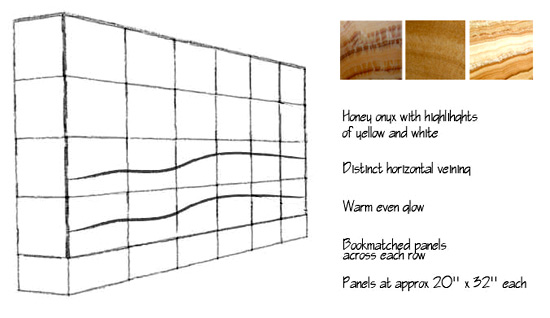Communicating Your Backlit Natural Onyx Designs – A Guide for Designers
Designing and specifying backlit onyx panels is a unique process. (Since onyx is a natural stone material, you can’t just call up Mother Nature and ask her to send samples of her latest collection.) This post outlines the three key items that you need to communicate in order for your backlit onyx design visions to become reality. Here we outline the necessary steps for designers to ensure their conceptual intent is properly translated:

1. Communicate the shade, coloration, and veining characteristics of the translucent onyx surface.
- Use photographs to communicate your preferences. As onyx is a highly exotic material, clearly establish color baselines and veining parameters with the use of targeted images. Typically, verbal and written descriptions will not sufficiently describe the nuances found across an onyx slab.
- In most cases, you will need to specify glass-backed translucent stone if even and continuous backlighting is desired. (Not all natural stone slabs transmit light, but in the process of slicing thinly and laminating to glass, nearly any type of stone can become transparent – even granite.)
2. Identify the backlighting method that suits your design aesthetic.
- Even illumination across entire face of onyx panel?
- Gradient wash that fades from one edge to another?
- Colored RGB lighting?
- Dimming capability? Would you/your client like the control and automation that comes with tying the LED backlighting into a central lighting control system?
3. Provide drawings of the application that indicate panel sizes and book-matched joints.
- If the backlit onyx panels must match surrounding stone or millwork finishes, make sure your backlit natural stone supplier has the exact panel sizes so that they can recommend stones that work within your module.
- If your exact panel sizes are flexible, that could open up more possibilities in the stone selection. (Remember, onyx is a natural material so it is not available in standard sheet sizes like man-made building materials.)
- Use standard drawing convention to indicate the bookmatching arrangement in your backlit onyx composition.
If you’re working with a backlit onyx supplier, as a designer you really just need to communicate numbers 1 through 3 above and they will take it from there. Proactive companies will act as part of your team to guide you through the subsequent steps: lighting design, mock-ups, detailing, structural engineering, quality control in production, and construction itself.
